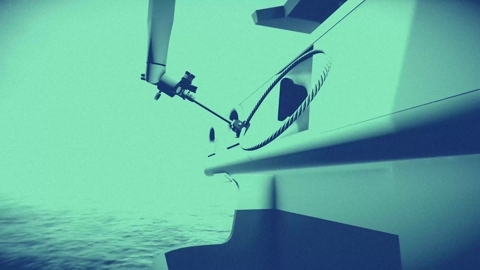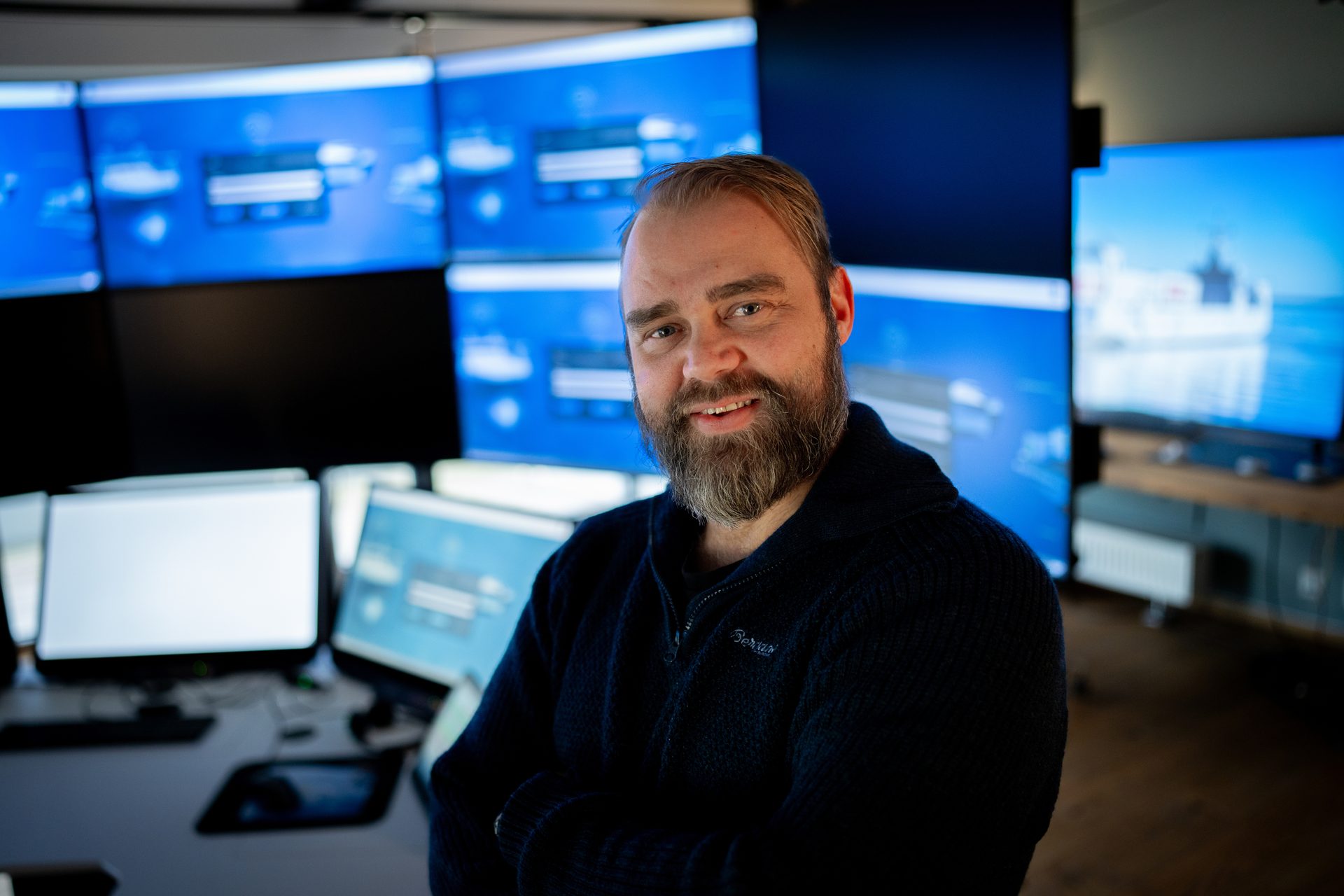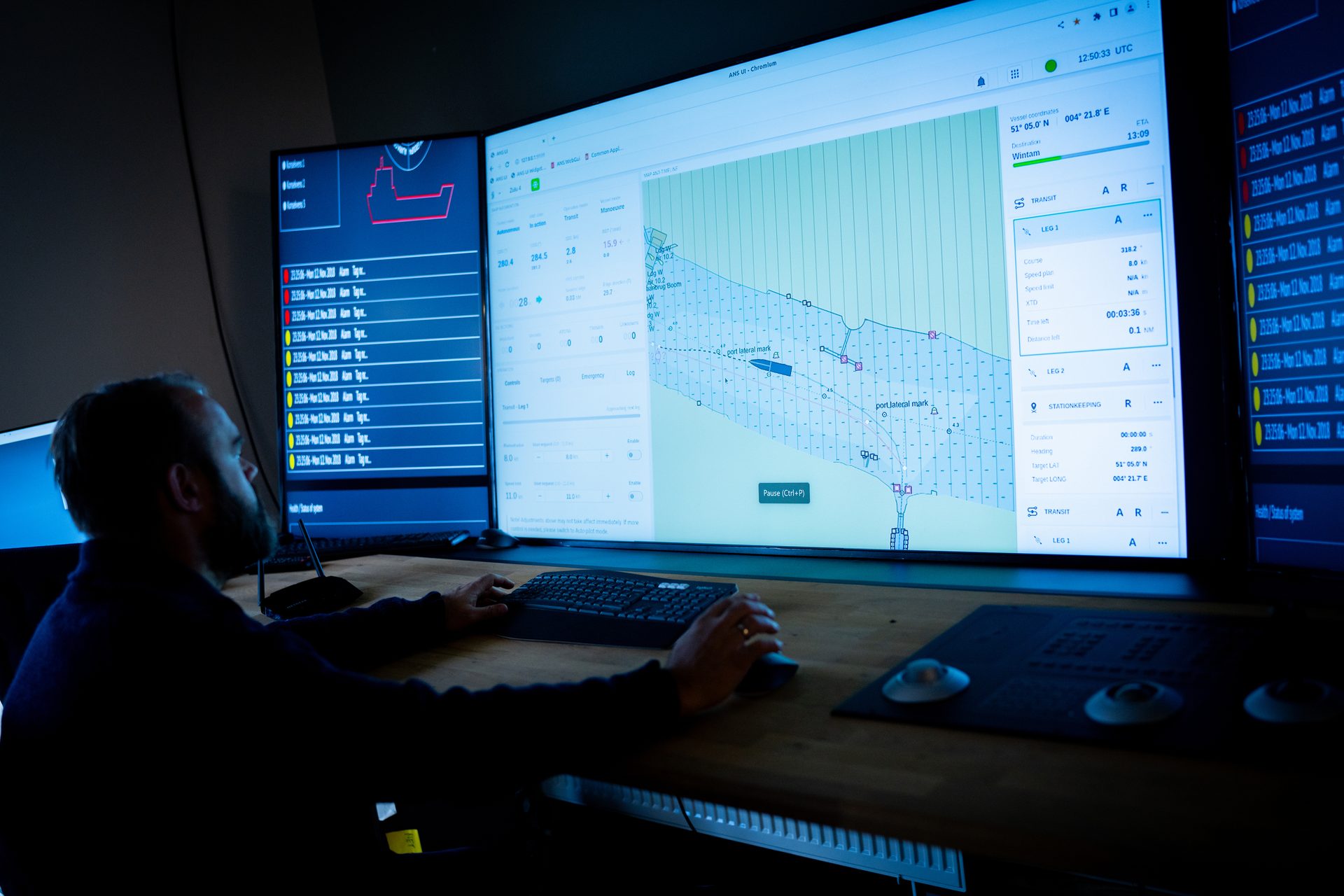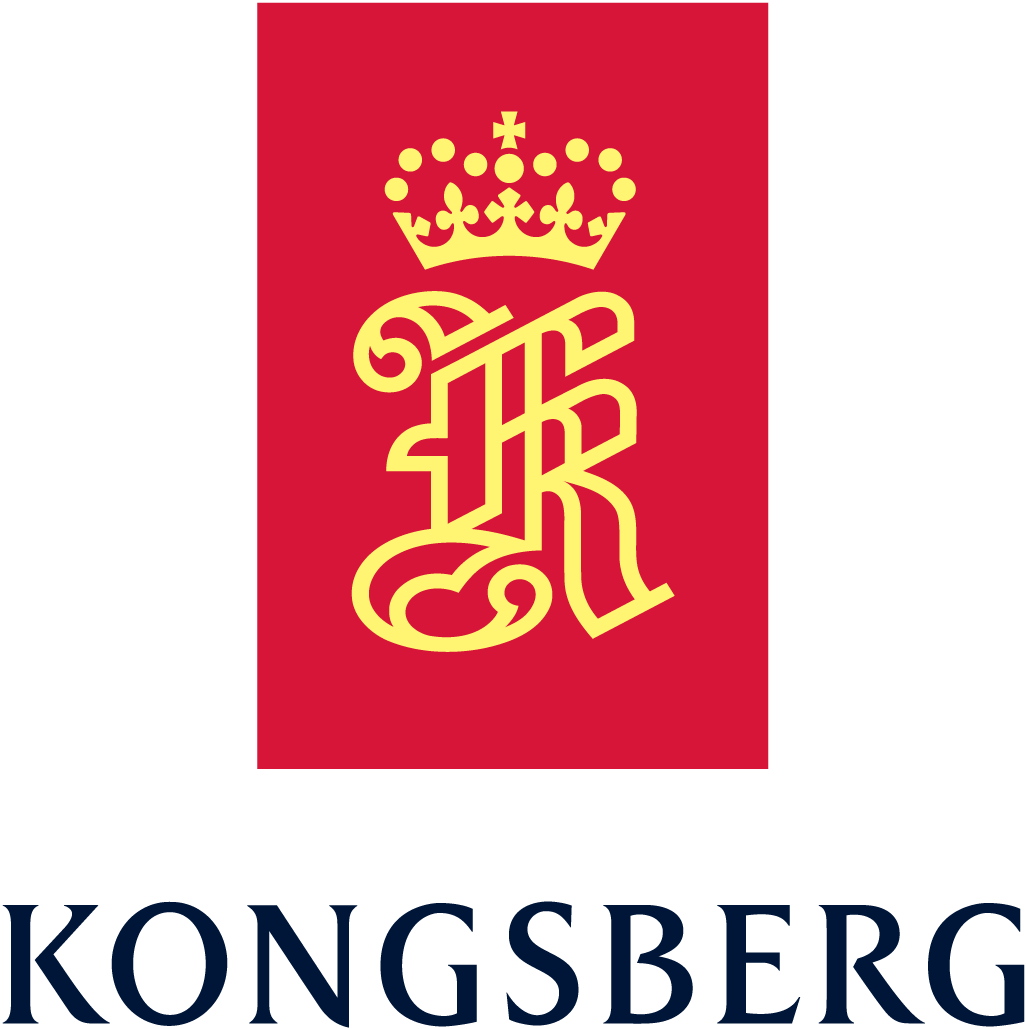
On land, the captain operates the world's first control centre of its kind.
The ship uses 70 percent
less energy per container compared to road transport, saving 40,000 truck journeys annually.
The ship uses 70 percent
less energy per container compared to road transport, saving 40,000 truck journeys annually.
As the first electric, autonomous ship ever, Yara Birkeland has gained global attention.

Plain sailing for Yara Birkeland
Journalist: Tina Aasen
Photo/video: Björn Audunn Blöndal / Yara / Kongsberg Gruppen
Quietly, the cargo ship glides through the water, it’s barely noticeable that it sails by with minimal crew on board. Most operations are handled by the ship itself, monitored from a control centre on land.
Merete Østby, Digital Manager at fertilizer company Yara, has been involved in the Yara Birkeland project since its inception in 2017—an electric ship sailing without crew. Since April 2022, Yara Birkeland has transported fertilizer containers from the factory in Porsgrunn to the export port in Brevik, three days a week, with plans to increase to five. Previously, trucks handled the freight, and at full operation, the ship annually saves the environment from 40,000 truck journeys.
"We had a need, and Kongsberg Maritime had the expertise – the perfect match. One of the main drivers behind the project was to reduce the environmental footprint, and the answer is clear. We can also say that sea transport is already economically viable," says Østby.
The energy consumption alone justifies the shift to sea transport. Yara Birkeland uses 70 percent less energy per container than land transport, eliminating road dust, noise, and CO2 emissions from diesel trucks in shuttle traffic. This has a significant impact, especially for the local population living along the transport route.


truck trips saved per year
less energy per container
39900
%
0

Merete Østby
Digital Manager, Yara
“Little did we know how significant this project would become. It's amazing that we achieved it; we're almost there, which is an accomplishment in itself.”
Merete Østby
Digital Manager, Yara
“Little did we know how significant this project would become. It's amazing that we achieved it; we're almost there, which is an accomplishment in itself.”
Merete Østby
Digital Manager, Yara

A system of sensors and computers ensures that Yara Birkeland sails to its destination while observing and learning along the way. Robot arms handle mooring and unmooring tasks autonomously.
Although there are still people on the bridge at all times in compliance with the law, their numbers are gradually decreasing. The Yara Birkeland crew started with five members when the ship was launched, but now they are three, soon to be reduced to two when the technician moves ashore.
A maritime revolution

A system of sensors and computers ensures that Yara Birkeland sails to its destination while observing and learning along the way. Robot arms handle mooring and unmooring tasks autonomously.
Although there are still people on the bridge at all times in compliance with the law, their numbers are gradually decreasing. The Yara Birkeland crew started with five members when the ship was launched, but now they are three, soon to be reduced to two when the technician moves ashore.
A maritime revolution
"The new generation of gamers needs jobs too."
At the control center in Horten, Roger Holm has full control—or in the ROC (Remote Operation Centre), as it's called. Yara Birkeland is monitored here, and any technical issues on board are addressed. Engineers are dispatched from here to fix problems, and if necessary, they can take over and remotely control the ship. Roger Holm currently has three autonomous vessels to oversee: Yara Birkeland, as well as Marit, and Therese, cargo ships of the food wholesaler Asko, shuttling between Horten and Moss.
Holm, COO of Massterly, is in charge of the operational management and crewing of autonomous ships.
"It's an exciting time. You have to challenge everything and everyone, including yourself. It's easy to fall into a 'this is how we've always done it at sea' mindset, but that doesn't work anymore. We need to challenge regulations; we need to move forward. In theory, we can monitor and control ships anywhere in the world. I can sit here in an ROC in Norway and sail in the Mediterranean," says Holm, who had a long seafaring career before coming ashore.
"I've been a captain on land since 2008, and it's going very well!"



"Remote controlled ships is something several companies have today, but what we are setting up here, a fully operated ROC, is the very first in the world."
Roger Holm
COO, Massterly
"Remote controlled ships is something several companies have today, but what we are setting up here, a fully operated ROC, is the very first in the world."
Roger Holm
COO, Massterly

Smarte skip endrer reglene
– Vi jobber ikke med autonomi for autonomiens skyld, men det åpner opp for et hav av muligheter, sier Pål Andrè Eriksen, Senior vice president i Kongsberg Maritime og ansvarlig for produkt- og teknologiutvikling med leveranser ombord på blant annet Yara Birkeland.
Veggen på møterommet hos Kongsberg Maritime i Horten er dekket av høydepunkter fra bedriftens spenstige, maritime historie. En serie nyskapninger og teknologiske gjennombrudd, og nå er vi altså kommet hit, til skip som navigerer farvann på egen hånd, og som overvåkes fra et kontrollsenter. Teamet jobber på spreng for å videreutvikle teknologien. Yara Birkeland har kickstartet en ny fremtid innen skipsfart.
– Siden regelverk og klassekrav fortsatt er under utvikling, fordrer de første stegene aktører som tør og vil investere i det ukjente, og YARA er en slik aktør. Innledningsvis blir det hybridløsninger, men på sikt skreddersydde og optimaliserte løsninger. Å levere skip ubemannet fra start i stedet for å redusere og minimere designet i etterkant er en helt ny måte å tenke på, sier Eriksen.
Det er mye å spare på lite eller ingen mannskap, som hviletid, søvnbehov og diverse fasiliteter, og det blir mindre rom for menneskelige feil. Det er lett å bare tenke tap av arbeidsplasser, men verden har forandret seg. Alle skip har i dag mye teknologi som krever høy kompetanse fra mannskapet. Å dra til sjøs er verken like enkelt eller like populært som før. Selvgående skip åpner samtidig for nye roller på land, inkludert personer som av ulike grunner ikke har anledning til å jobbe ombord et fartøy, som at man sitter i rullestol eller må hente ungene i barnehagen 16.00.
Yara Birkeland navigerer i travle farvann ved Grenland og sikkerheten må være på et nivå som er godt nok før skipet får seile helt uten mannskap. Pål André Eriksen sikter mot en gang i 2025. Før dette vil Kongsberg Maritime adressere rolle for rolle om bord på fartøyet og sikre etablering av funksjonalitet og tilhørende rammeverk i tett dialog med DNV. Men det er Sjøfartsdirektoratet som til slutt avgjør når det kan skje.
«En global trend er mangel på sjøfolk, dette ser vi også her til lands, det er også utfordringer knyttet til tilgang på relevant kompetanse. Faren min mønstret på da han var 16, men dette er vel ikke akkurat standarden lenger.»

Smart ships change the rules
"We're not working on autonomy for autonomy's sake, but it opens up a sea of possibilities," says Pål André Eriksen, Senior Vice President at Kongsberg Maritime, responsible for product and technology development, including deliveries on Yara Birkeland.
The meeting room wall at Kongsberg Maritime in Horten is adorned with highlights from the company's innovative maritime history. A series of breakthroughs and technological advancements have led to this point—ships navigating waters on their own, monitored from a control center. The team is working tirelessly to further develop the technology. Yara Birkeland has kickstarted a new future for shipping.
"Since regulations and class requirements are still evolving, the initial steps require actors willing to invest in the unknown, and YARA is one such actor. Initially, there will be hybrid solutions, but eventually, tailored and optimized solutions. Delivering unmanned ships from the start, rather than minimizing design afterward, is an entirely new way of thinking," says Eriksen.
There's much to save with minimal or no crew—rest time, sleep requirements, and various amenities—and less room for human errors. It's easy to think only of job losses, but the world has changed. All ships today have advanced technology that requires high competence from the crew. Going to sea is neither as simple nor as popular as it used to be. Autonomous ships also create new onshore roles, including for those who, for various reasons, cannot work on a vessel, such as being in a wheelchair or needing to pick up children at 4:00 p.m.
Yara Birkeland navigates in busy waters near Grenland, and safety must reach an adequate level before the ship can sail entirely without a crew. Pål André Eriksen aims for some time in 2025. Before that, Kongsberg Maritime will address role by role on board the vessel, ensuring the establishment of functionality and associated frameworks in close dialogue with DNV. However, it is the Maritime Directorate that ultimately decides when it can happen.
"A global trend is a shortage of seafarers; we see this here in the country too. There are also challenges related to access to relevant expertise. My father signed on when he was 16, but that's not exactly the standard anymore"
Kongsberg Maritime is developing, modernizing and commercializing technology to increase the level of automation in both existing and new vessels. The goal is to have a scalable solution ready by 2026.
Kongsberg Maritime is developing two Reach vessels for various sea operations and will deliver two autonomous ferries to Stockholm by late 2024.
Marit and Therese are two autonomous freight ships for Asko, running between Moss and Horten.
Kongsberg has several autonomous vessels in development.
The 80-meter-long Yara Birkeland weighs 3.200 tons. The ship can navigate itself or be remotely controlled, eliminating the need for on-board crew. Equipped with electric batteries, it has zero emissions during operation.
Machine learning trains the ship to identify objects, allowing it to recognize what appears on water or in the air. On the autonomy scale, Yara Birkeland is at level four, the current maximum, but the ship is still in a two-year testing period before reaching the required level for autonomous operation. Regulations must also change.
Efforts are underway to transfer roles from the ship to the land-based control center. Currently, there are people on the bridge at all times, but the ship operates autonomously, equipped with robot arms for mooring in existing ports. Yara has also established a new container terminal with an automated crane in Herøya, Porsgrunn.
Yara Birkeland
100% autonomous electric vessels are most suitable for short-distance traffic, such as ferries and smaller cargo ships.
The EU's goal is to shift 50% of current short-distance transport from trailers to rivers, lakes, seas, and trains, significantly relieving pressure on the European road network.
For long-distance cargo ships, Kongsberg Maritime's technology can optimize operations, develop support systems, and control systems that both reduce crewing and enhance maritime safety.
Shipping accounts for 3% of total global greenhouse gas emissions, and efforts worldwide are underway to transition ships to alternative energy sources beyond fossil fuels.
Reducing pollution and easing road congestion
More stories from Kongsberg Gruppen




